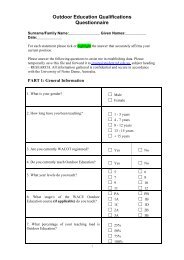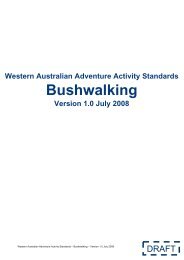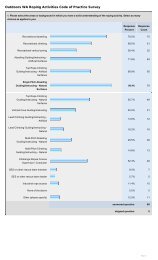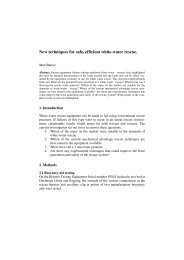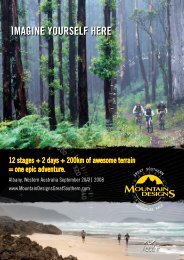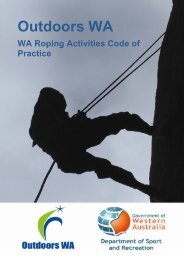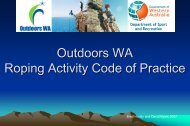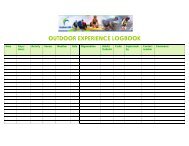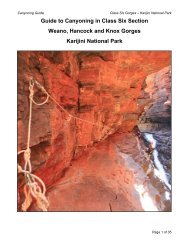Outdoor Adventure Activities Benefits Catalogue - Outdoors WA
Outdoor Adventure Activities Benefits Catalogue - Outdoors WA
Outdoor Adventure Activities Benefits Catalogue - Outdoors WA
Create successful ePaper yourself
Turn your PDF publications into a flip-book with our unique Google optimized e-Paper software.
2.1. <strong>Outdoor</strong> adventure activitiesIt should be stated at the outset of this review that the emphasis is upon human-poweredactivities in the outdoors. As such, there is a focus upon the active involvement in physicalactivities conducted in the outdoors. The authors are also cognizant of ‘feeder’ adventureactivities that may be indoors such as climbing gymnasiums and exercise bicycles. The maininterest of this review pertains to those activities occurring in natural or non-urbanenvironments. The reason for this latter emphasis is duplication of the substantial work byDeakin University, which is currently being updated, that has focused upon more urbanenvironments such as parks and gardens (Mallar, Townsend, Brown, & St Leger, 2002a,2002b).By focusing upon human-powered outdoor adventure activities, a wide range of possibleactivities are included such as hiking, mountain biking, climbing and canoeing. In seeking todefine ‘outdoor adventure’ Ewert (1989) made reference to a range of definitions thatincorporated elements of physical danger, creating meaningful human experiences,involvement in the outdoors, and facing a challenge. Terms such as outdoor recreation, aretotally artificial constructs (Mercer, 1994) that seek to place definitional limits over, often,blurred realities. For example, rock climbing is often considered an outdoor adventureactivity, however, with the proliferation of indoor climbing gyms, many people may use theequipment and techniques of rock climbing, but never actually venture outdoors to climb onnatural rock surfaces. By participating, albeit indoors, they may achieve similar benefits interms of physical activity, group cohesion and sense of ‘flow’ (Csikszentimihalyi, 1990) butwith less time and travel costs. While this review has focused upon outdoor adventureactivities, other research has been included that is not necessarily adventure, but still has beenthe element of human-powered activity conducted in the outdoors.The context in which these activities occur is also of importance. Again, using the broadestbrush possible, the research included in this review, as suggested by the methodology, hasbeen drawn from areas such as education, recreation, tourism, environment, religion, health,therapy and business and has occurred in protected areas, on the water, in remote areas and inurban environments2.2. <strong>Benefits</strong> frameworksThere have been a variety of models/frameworks used to analyse benefits of outdoor andadventure activities. These recent models and frameworks as presented in Stiehl and Parker(2007) have been summarised in Tables 1-4 over the page.The following sections of this report outline the methodology used to gather the wide range ofresearch and reports, followed by the presentation of the results. The results include asummary of seven previous reviews of the benefits of sport, recreation and exercise that havebeen conducted world-wide, followed by an analysis of the research and reports identified inthis review. Given the emphasis upon the health benefits of participating in outdooradventure activities, further information is presented about Australia’s efforts in relation tohealth and physical activity, including a summary of recent government policies andstrategies.Page 2






